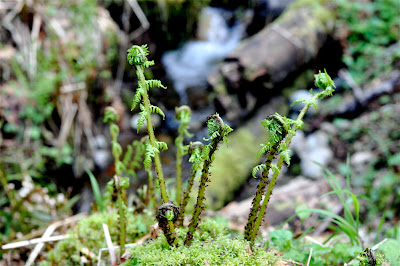 THE BEST WAY to forage a fiddlehead patch is to identify the adult ferns in summer, when their fronds are easily recognized, then go back in spring and pick the newly emerged fiddleheads.
THE BEST WAY to forage a fiddlehead patch is to identify the adult ferns in summer, when their fronds are easily recognized, then go back in spring and pick the newly emerged fiddleheads.One of my favorite Sichuanese dishes—a signature preparation known to even casual admirers of the spicy cuisine from southwestern China—is Dry-fried String Beans. Use fiddleheads in place of string beans for an earthy change of pace.
Prep the fiddleheads carefully. Soak in water a few minutes before rubbing off the papery sheaf with your fingers. Blanche in salted boiling water for half a minute, then thoroughly dry with paper towels. It’s important to not overcook the fiddleheads as they will turn soft and unwind.

1 lb fiddleheads, cleaned
1/4 lb ground pork
1/3 cup peanut oil
1 tbsp garlic, diced
1 tbsp ginger, diced
10 dried red chili peppers
1/4 tsp Sichuan peppercorns, ground
2 tbsp Sichuan preserved vegetable, chopped
3 scallion bulbs, chopped
2 tsp Chinese rice wine (or dry sherry)
1 tbsp chili bean sauce
1/2 tsp sesame oil
1/2 tsp dark soy sauce
1 tsp sugar
1/4 tsp salt, or more to taste
1. Combine rice wine, chili bean sauce, sesame oil, dark soy sauce, and sugar in small bowl to make sauce. Set aside.
2. Blanche fiddleheads for 1/2 minute in boiling, well-salted water. Remove and dry thoroughly with paper towels.
3. Heat oil in wok until nearly smoking, then add fiddleheads and stir-fry for a couple minutes until beginning to blister but still firm. Remove to paper towels.
4. Pour off all but a tablespoon of oil and return to heat. Add garlic, ginger, chopped scallion bulbs, red chili peppers, preserved vegetable, and Sichuan peppercorns. Cook a minute until fragrant, then add ground pork. Stir-fry together until pork is browned. Return fiddleheads to wok, add reserved sauce, and stir-fry another minute to coat.
5. Sprinkle with salt and serve.



On a search for fiddleheads, I found some that looked perfect, coiling tightly just above the ground. But these are furry, and they don’t want to remove their coats anytime soon, even with a good soaking.
The mature fronds look much like ostrich ferns, and may be the very thing. I’m not sure. I found them near Seattle. They are a more dull green when mature though, more like an Army green.
I wish I had a photo, but the camera is out of batteries at present. Does it sound like I’ve got anything edible here or should I keep searching?
Thanks!
Hi Kristen – Lady fern fiddleheads will shed their coats fairly easily with a little water and thumb wrestling. In my classes we’ve had the good fortune of seeing lady ferns, buckler ferns, sword ferns, and bracken ferns all growing from the same patch of ground for easy comparison. Send a photo if you get a chance.
great idea, had no idea you could eat them. you learn something every day.
Not so much in the vein of this particular article, but more in the spirit of our love for amazing food.
New York’s answer to home cooked food and some Mum love…
Amazing!
http://newyorkknowsbest.wordpress.com/2011/05/01/no-one-does-it-like-mom/
I’m so excited to find your blog! I appreciate your knowledge around this and look forward to reading future posts if not just for the awesome recipes! Thanks 🙂
Nice dish! Love Sichuan cooking, and that is a perfect wild sub-in for the beans. Might have to borrow that one someday…
BTW, I’ve now eaten both Lady Fern and Ostrich Fern and I have to say the East has it on us — just not a fan of the Lady Fern. Too tannic and bitter for me.
This comment has been removed by the author.
So, it’s getting a little late in the season for fiddleheads, and I’m wondering just how tight the fronds need to be to be edible? I was out today and only found two still neatly furled, about 3 and 5 inches tall. There were still a number of ones mostly curled, about 10 inches tall, but with the very lowermost leaves present on the stalk. They’re only tiny leaflets. Are these still okay? BTW, I love your blog, tons of great information!